Developing a Framework to Integrate Circularity into Construction Projects
Abstract
1. Introduction
- Which information needs to be included in the framework for project managers to implement the concept of a circular economy in the initiation and definition phases of construction projects?
- How to design the framework?
- How to validate the framework?
2. Methods
2.1. Case-Based Research
- Traditional project (management) implies that a project is realised according to the current management and executed according to the take–make–dispose plan, also known as the linear economy. Within a traditional project, circularity does not occur in the questioning (belonging to the initiation and definition phases) or in the realisation or execution of the project.
- Semi-circular project (management) indicates that the managed project consists of (a few) components according to the circular economy.
2.2. Interviews
2.3. Fuzzy Delphi Method
- Validate predefined list of factors
- 2.
- Collect opinions of expert group
- 3.
- Set up overall triangular fuzzy number
| R1 | R2 | … | Rn | |
| SF1 | L11 | L12 | … | L1n |
| SF2 | L21 | L22 | … | L2n |
| … | … | … | … | … |
| SFm | Lm1 | Lm2 | … | Lmn |
- 4.
- Defuzzification
- 5.
- Screen evaluation indexes
3. Results
3.1. (Real-World) Problem Investigation
3.1.1. Three Identified Steps for a Circular Project Approach
3.1.2. The Role of a Project Manager in a Circular Project and Their Current Knowledge in the Field of Circular Economy
3.1.3. Identified Success Factors to Help Project Managers Integrate Circularity in Construction Projects
3.1.4. Determining the Requirements for the Framework
- (1)
- As a basic model to illustrate the process of a circular approach and the consequences of a circular approach for the project;
- (2)
- To explain to the client why a circular approach is required, how it can be achieved and what a circular approach means for the project;
- (3)
- Interactively by the project manager and by the client to discuss a circular approach for the project;
- (4)
- As a checklist to realise projects according to the circular concept.
3.2. Phase 2—Solution Design
3.2.1. Which Frameworks Do Exist and What Should They Look Like?
3.2.2. Creating the Framework
3.3. Phase 3—Solution Validation
Validating the Framework
4. Discussion
5. Conclusions
Author Contributions
Funding
Institutional Review Board Statement
Informed Consent Statement
Data Availability Statement
Conflicts of Interest
Appendix A. List of 66 Success Factors
| No. SF | Main Category | Sub-Category | Success Factor | Literature | Research Result | Result | Rank |
|---|---|---|---|---|---|---|---|
| 1 | Project preparation | Ambition | There is a circular ambition and vision from the client | X | accepted | 1 | |
| 2 | Project preparation | Ambition | An ambition document has been drawn up for the project | X | accepted | 12 | |
| 3 | Project preparation | Ambition | Circular ambitions are inventoried, formulated and translated into project objectives as soon as possible | [21,22,93,94] | X | accepted | 3 |
| 4 | Project preparation | Ambition | The client is made aware of their possible (circular) ambitions and the new developments in the market | X | rejected | 35 | |
| 5 | Project preparation | Objectives | Circularity is an additional objective within the project | X | rejected | 63 | |
| 6 | Project preparation | Objectives | Circular objectives are formulated in a way that is achievable and measurable | [93] | X | rejected | 28 |
| 7 | Project preparation | Approach project preparation | The concept of circularity is defined and documented in the project | X | rejected | 51 | |
| 8 | Project preparation | Approach project preparation | Circular project requirements are formulated by the entire project team | [21] | X | rejected | 32 |
| 9 | Project preparation | Approach project preparation | Circular project requirements will be drawn up | X | accepted | 6 | |
| 10 | Project preparation | Approach project preparation | Support for a circular approach from the client ensures a circular outcome at project level | [3] | X | accepted | 17 |
| 11 | Project preparation | Approach project preparation | Additional time will be reserved for setting ambitions, drawing up an ambition document and formulating objectives | X | accepted | 14 | |
| 12 | Project preparation | Role project manager | The project manager should initiate a conversation with the client about the circular ambitions and the possibility of integrating circularity in their projects | X | rejected | 40 | |
| 13 | Project preparation | Role project manager | The project manager should question the client whether the project can be connected to (other) existing circular/sustainability ambitions of the company | [95] | X | accepted | 19 |
| 14 | Project preparation | Role project manager | The project manager should be able to explain to the client what the consequences of a circular approach are in relation to the project | X | accepted | 20 | |
| 15 | Project preparation | Role project manager | The project manager has to create awareness and support from the client for a circular approach towards the project | [3] | X | rejected | 33 |
| 16 | Project management | Approach project management | The circular objective is outlined on the horizon and divided into small steps. After every step, it is evaluated, and follow-up steps are considered | X | rejected | 37 | |
| 17 | Project management | Approach project management | All phases in which the building is involved are included in the project; both the construction phases from initiation to realisation and the subsequent maintenance and disassembly phases | X | accepted | 21 | |
| 18 | Project management | Approach project management | A circular approach also includes a circular service; come up with a solution from the beginning, provide a solution and remain involved during the life cycle so that solutions remain as optimal as possible | X | rejected | 38 | |
| 19 | Project management | Approach project management | The project collects pre- and post-information on design and demolition process | [96] | X | rejected | 58 |
| 20 | Project management | Approach project management | Opportunity cards will be made about circular ideas and opportunities in the area that can be linked to the project | X | rejected | 43 | |
| 21 | Project management | Approach project management | Sustainability/circularity is managed | X | rejected | 30 | |
| 22 | Project management | Approach project management | A market consultation will be held to test the circular requirements and ambitions | X | rejected | 62 | |
| 23 | Project management | Approach project management | Attention is paid to ensure that an interactive process can be created in the design and realisation phase | X | rejected | 53 | |
| 24 | Project management | Approach project management | In a project, the focus is on what is close to the scope and within reach of the project | [93] | X | rejected | 44 |
| 25 | Project management | Approach project management | Client must be challenged to innovate; this is not only the task for market parties/stakeholders in a circular approach | X | rejected | 54 | |
| 26 | Project management | Procurement | In the project, agreements are made (with new contract forms) so that materials do not end up as waste | [21] | accepted | 15 | |
| 27 | Project management | Management | Project information is shared efficiently and transparently so that information does not get lost and the idea does not have to be reinvented | [3,21,93] | accepted | 18 | |
| 28 | Project management | Management | The project/project team is flexible to review requirements in subsequent phases | X | rejected | 47 | |
| 29 | Project management | Management | Clients take more risks to stimulate innovation and creativity | [21] | X | rejected | 61 |
| 30 | Project management | Management | Stakeholders abandon their standard approaches and routines and take more risks | [94] | X | rejected | 56 |
| 31 | Project management | Management | Examples of other circular projects are used to inspire and to show that circularity can also be accessible and that not everything has to be applied at once | X | accepted | 5 | |
| 32 | Project management | Management | There is knowledge of the existing legislation, and regulations in the field of circularity and circular solutions are examined within these boundaries | [94] | X | rejected | 55 |
| 33 | Project management | Management | Time for reflection is included in the process to evaluate the project, reflect on the team members, inspire each other and challenge each other on whether the ideas can be made even more sustainable and efficient | X | accepted | 27 | |
| 34 | Project management | Management | Projects are digitized by means of BIM, a digital twin or a material passport | [97] | X | accepted | 23 |
| 35 | Project management | Project team | The project team uses non-hierarchical organisational structures | [21] | rejected | 66 | |
| 36 | Project management | Project team | The project team includes people who can think outside the box | X | accepted | 11 | |
| 37 | Project management | Project team | Conditions to collaborate in a project are facilitated | [3] | X | accepted | 26 |
| 38 | Project management | Project team | The project team has knowledge of the concept of circularity | X | accepted | 7 | |
| 39 | Project management | Project team | The project team understands each other, and the members share the same circular goals, vision and philosophy | [21] | X | accepted | 13 |
| 40 | Project management | Project team | Trust is the basic principle between the client and the contracted party, but a contract remains necessary | X | rejected | 60 | |
| 41 | Project management | Project team | All the interests of all parties are shared, and there is an understanding of certain choices and points of view | rejected | 48 | ||
| 42 | Project management | Project team | All stakeholders involved in the project are motivated, both at company and personal level, to organise the project in a circular way | [93] | X | accepted | 22 |
| 43 | Project management | Project team | An external party joins the project team that has knowledge of circularity, can ensure the knowledge and can tell what is currently the highest achievable point in the market | X | rejected | 34 | |
| 44 | Project management | Project team | Increasing cooperation with new, multidisciplinary and international teams | X | rejected | 64 | |
| 45 | Project management | Project team | There is a transparent cooperation with involved parties in order to promote the development of new concepts and sustainable collaborations | [3,93] | X | rejected | 42 |
| 46 | Project management | Project team | There is confidence in the market and opportunity for innovation in the process | X | rejected | 45 | |
| 47 | Project management | Project team | In addition to the scope of the building, the project team also investigates possibilities for connecting the project to circular ideas of the area | X | rejected | 39 | |
| 48 | Project management | Project team | Client participates in the project team | X | rejected | 49 | |
| 49 | Project management | Budget | On top of a traditional budget estimation, 10-15% is added for a circular approach | X | rejected | 36 | |
| 50 | Project management | Budget | An inventory is made of additional financial resources at the client’s organisation for sustainable/circular alternatives (such as tuition fees, sustainability budget) | X | accepted | 24 | |
| 51 | Project management | Budget | The budget of the project is managed in a transparent way | [21] | rejected | 59 | |
| 52 | Project management | Budget | The residual value of materials/the building is included in the budget if it can be deducted from the investment | X | rejected | 31 | |
| 53 | Project management | Procurement | The market is involved in the process during initiation and/or definition phase | [22] | X | rejected | 41 |
| 54 | Project management | Procurement | A construction team will be integrated into the early phases of the project, based on trust, intended cooperation and suggested approach rather than money and quality | [94] | X | rejected | 29 |
| 55 | Project management | Procurement | Circularity must be clearly formulated in invitations to tender | [94,98] | X | accepted | 8 |
| 56 | Project management | Procurement | Tendering for market parties early in the project ((end of) definition phase) | [21] | X | rejected | 57 |
| 57 | Project management | Procurement | Select stakeholders with the entire project team | [21] | rejected | 65 | |
| 58 | Project management | Procurement | The concept of circularity is included in selection criteria | [94] | X | accepted | 9 |
| 59 | Project management | Procurement | Selecting market parties on the basis of a competitive dialogue and assessing the proposed approach to them | [22] | X | rejected | 50 |
| 60 | Project management | Role project manager | Project manager has basic knowledge of the concept of circularity, understands the concept of a circular economy, is able to involve an advisor when necessary and can translate the knowledge into their own projects | X | accepted | 4 | |
| 61 | Project management | Role project manager | Project manager knows that circularity can be a challenge for the client | [3] | X | accepted | 25 |
| 62 | Project management | Role project manager | Project manager has the courage to change, is curious about the concept of circularity, wants to try out new techniques and sees the urgency of a transition to a circular economy | X | accepted | 10 | |
| 63 | Project management | Role project manager | Circularity is always an ambition of the project manager within the established requirements of the client | X | rejected | 46 | |
| 64 | Project management | Role project manager | The project manager is critical towards the client, discusses the established requirements of the project and asks why these requirements exist | X | accepted | 16 | |
| 65 | Project management | Role project manager | The project manager has intrinsic motivation and creates enthusiasm which convinces the client about a circular approach | X | accepted | 2 | |
| 66 | Project management | Role project manager | The project manager starts defining a process model for the project instead of drawing up a programme of requirements | [22] | rejected | 52 |
Appendix B. The Developed Framework
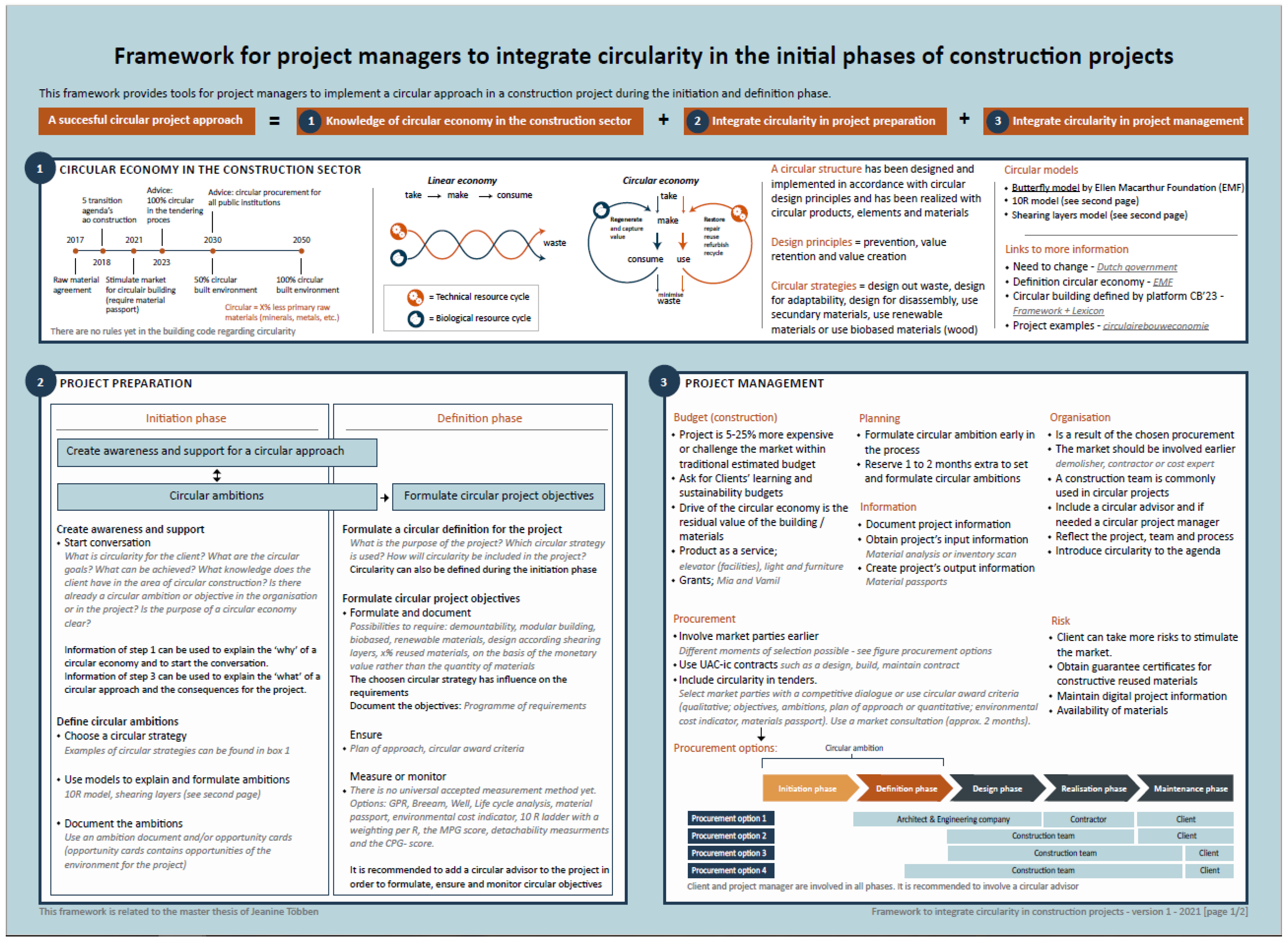
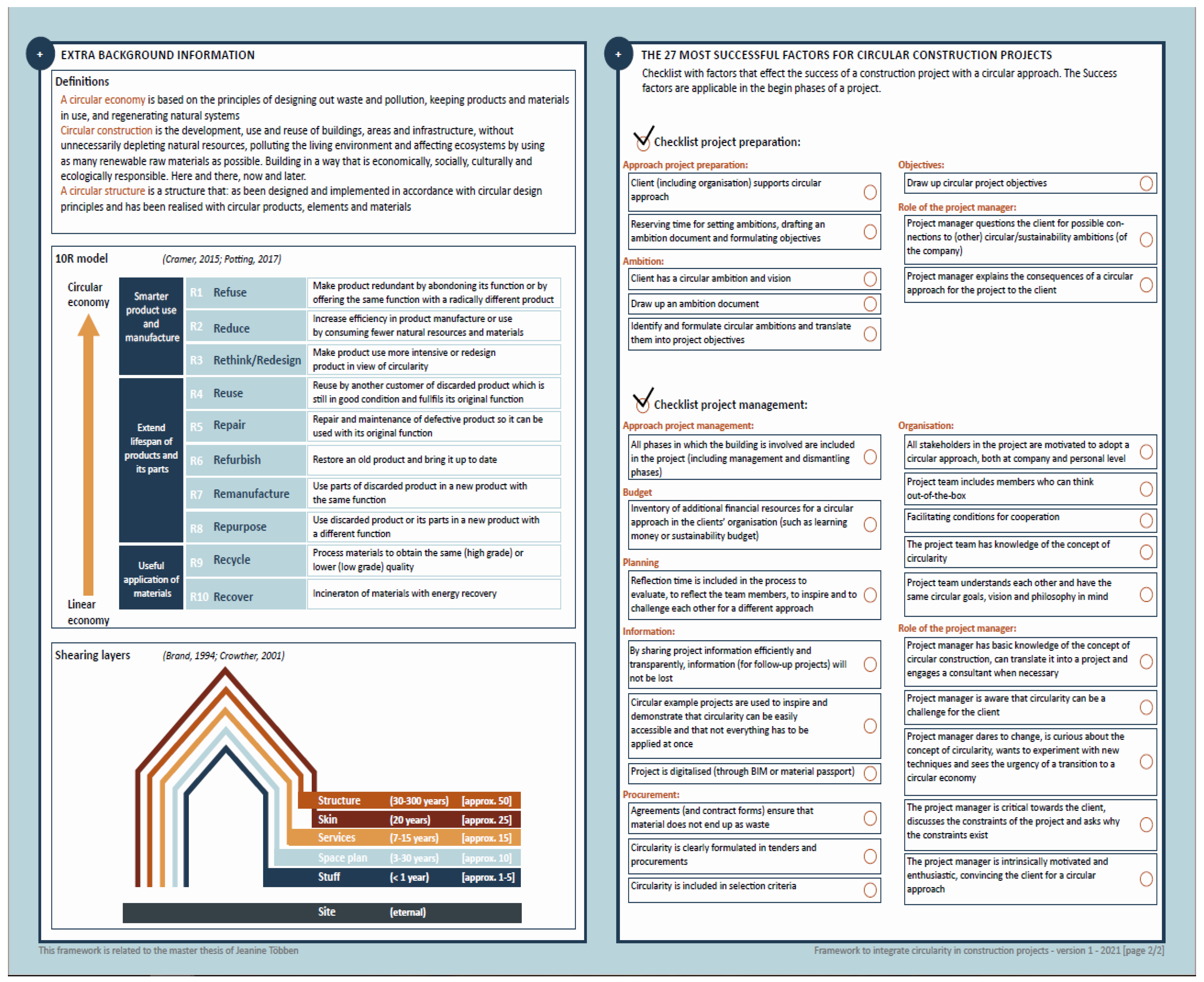
References and Notes
- Kok, L.; Wurpel, G.; Ten Wolde, A. Unleashing the Power of the Circular Economy. 2013. Available online: https://www.viawater.nl/files/unleashing_the_power_of_the_circular_economy-circle_economy.pdf (accessed on 17 March 2020).
- Verberne, J. Bilding Circularity Indicators—An Approach for Measuring Circularity of a Building. Master’s Thesis, Eindhoven University of Technology, Eindhoven, The Netherlands, 2016. [Google Scholar]
- Adams, K.; Osmani, M.; Thorpe, T.; Hobbs, G. The Role of the Client to enable Circular Economy in the Building Sector. HISER International Conference 2017: Advances in Recycling and Management of Construction and Demolition Waste 2017. pp. 118–121. Available online: https://repository.tudelft.nl/islandora/object/uuid:51ba494a-fdf4-41a9-8f65-87140dfd5d97?collection=research (accessed on 19 April 2020).
- Ministerie van Infrastructuur en Waterstaat. Uitvoeringsprogramma Circulaire Economie 2019–2023. 2019. Available online: https://www.rijksoverheid.nl/documenten/rapporten/2019/02/08/uitvoeringsprogramma-2019-2023 (accessed on 18 March 2020).
- Rijksoverheid. Nederland Circulair in 2050—Rijksbreed Programma Circulaire Economie. 2016. Available online: https://www.rijksoverheid.nl/onderwerpen/circulaire-economie/documenten/rapporten/2016/09/14/bijlage-1-nederland-circulair-in-2050 (accessed on 18 March 2020).
- Prins, M.; Mohammadi, S.; Slob, N. Radical Circular Economy. 2015. Available online: http://resolver.tudelft.nl/uuid:b80ad8fd-3ffc-48cf-a1b6-82554a3a9a3c (accessed on 4 June 2020).
- Yadav, M.; Agarwal, M. Biobased building materials for sustainable future: An overview. Mater. Today Proc. 2021, 43, 2895–2902. [Google Scholar] [CrossRef]
- Dittenber, D.B.; Gangarao, H.V.S. Critical review of recent publications on use of natural composites in infrastructure. Compos. Part A Appl. Sci. Manuf. 2012, 43, 1419–1429. [Google Scholar] [CrossRef]
- Eberhardt, L.C.M.; Birgisdottir, H.; Birkved, M. Potential of Circular Economy in Sustainable Buildings. IOP Conf. Ser. Mater. Sci. Eng. 2019, 471, 11. [Google Scholar] [CrossRef]
- Kubbinga, B.; Bamberger, M.; van Noort, E.; van den Reek, D.; Blok, M.; Roemers, G.; Hoek, J.; Faes, K. A Framework for Circular Buildings—BREEAM. 2018. Available online: https://www.dgbc.nl/a-framework-for-circular-buildings-47 (accessed on 8 March 2020).
- Többen, J.C.A. Developing a Framework to Integrate Circularity in Construction Projects: Creating a Framework for Project Managers to Integrate Circularity in the Initiation and Definition Phase of Construction Projects. Master’s Thesis, Eindhoven University of Technology, Eindhoven, The Netherlands, 2021. [Google Scholar]
- Ellen MacArthur Foundation; McKinsey & Company; World Economic Forum. Towards the Circular Economy: Accelerating the Scale-Up across Global Supply Chains. 2014. Available online: http://www3.weforum.org/docs/WEF_ENV_TowardsCircularEconomy_Report_2014.pdf (accessed on 8 March 2020).
- Okorie, O.; Salonitis, K.; Charnley, F.; Moreno, M.; Turner, C.; Tiwari, A. Digitisation and the circular economy: A review of current research and future trends. Energies 2018, 11, 3009. [Google Scholar] [CrossRef]
- Ghisellini, P.; Ripa, M.; Ulgiati, S. Exploring environmental and economic costs and benefits of a circular economy approach to the construction and demolition sector. A literature review. J. Clean. Prod. 2018, 178, 618–643. [Google Scholar] [CrossRef]
- Kirchherr, J.; Reike, D.; Hekkert, M. Conceptualizing the circular economy: An analysis of 114 definitions. Resour. Conserv. Recycl. 2017, 127, 221–232. [Google Scholar] [CrossRef]
- Ellen Macarthur Foundation. Towards a Circular Economy: Business Rationale for an Accelerated Transition. 2015. Available online: https://www.ellenmacarthurfoundation.org/publications/towards-a-circular-economy-business-rationale-for-an-accelerated-transition (accessed on 8 March 2020).
- Arup. The Circular Economy in the Built Environment. 2016. Available online: https://www.arup.com/perspectives/publications/research/section/circular-economy-in-the-built-environment (accessed on 19 March 2020).
- Rau, T.; Oberhuber, S. Material Matters; Betram + de Leeuw Uitgevers Bv: Haarlem, The Netherlands, 2016; ISBN 9789461562258. [Google Scholar]
- Leising, E.; Quist, J.; Bocken, N. Circular Economy in the building sector—Three cases and a collaboration tool. J. Clean. Prod. 2017, 176, 976–989. [Google Scholar] [CrossRef]
- Personal communication with a project manager of Sweco. 2020. Microsoft Teams. 17 March 2020.
- Versteeg Conlledo, A.T. Managing Circular Construction Projects. Master’s Thesis, Delft University of Technology, Delft, The Netherlands, 2019. [Google Scholar]
- Venselaar, M.; Heinz, J.; Lousberg, L. Managing circular building projects. In Proceedings of the Project Management Conference, Delft, The Netherlands, 11–12 April 2019; pp. 1–18. [Google Scholar]
- RIBA. RIBA Plan of Work 2020 Overview. 2020. Available online: https://www.architecture.com/-/media/GatherContent/Test-resources-page/Additional-Documents/2020RIBAPlanofWorkoverviewpdf.pdf (accessed on 5 February 2021).
- van Aken, J.E. Management research as a design science: Articulating the research products of mode 2 knowledge production in management. Br. J. Manag. 2005, 16, 19–36. [Google Scholar] [CrossRef]
- Dresch, A.; Lacerda, D.P.; Antunes, A.V., Jr. Design Science Research; Springer International Publishing: Cham, Switzerland, 2015; ISBN 978-3-319-07373-6. [Google Scholar]
- Starkey, K.; Madan, P. Bridging the Relevance Gap: Aligning Stakeholders in the Future of Management Research. Br. J. Manag. 2001, 12, S3–S26. [Google Scholar] [CrossRef]
- Hatchuel, A.; Weil, B.C.-. K design theory: An advanced formulation. Res. Eng. Des. 2009, 19, 181–192. [Google Scholar] [CrossRef]
- Dellantonio, S.; Mulatti, C.; Job, R. Artifact and tool categorization. Rev. Philos. Psychol. 2013, 4, 407–418. [Google Scholar] [CrossRef][Green Version]
- van Aken, J.; Berends, H.; van der Bij, H. Problem Solving in Organizations, 2nd ed.; Cambridge University Press: Cambridge, UK, 2012; ISBN 9781139094351. [Google Scholar]
- Wieringa, R.J. Design Science Methodology for Information Systems and Software Engineering; Springer: Berlin/Heidelberg, Germany, 2014; ISBN 978-3-662-43838-1. [Google Scholar]
- van Aken, J.E.; Romme, G. Reinventing the future: Adding design science to the repertoire of organization and management studies. Organ. Manag. J. 2009, 6, 5–12. [Google Scholar] [CrossRef]
- Yin, R. Case Study Research and Applications, 6th ed.; SAGE Publications: Los Angeles, CA, USA, 2018. [Google Scholar]
- Yin, R. Case Study Research Design & Methods; SAGE Publications: Los Angeles, CA, USA, 2003. [Google Scholar]
- Glumac, B.; Han, Q.; Smeets, J.; Schaefer, W. Brownfield redevelopment features: Applying Fuzzy Delphi. J. Eur. Real Estate Res. 2011, 4, 145–159. [Google Scholar] [CrossRef]
- Ishikawa, A.; Amagasa, M.; Shiga, T.; Tomizawa, G.; Tatsuta, R.; Mieno, H. The max-min Delphi method and fuzzy Delphi method via fuzzy integration. Fuzzy Sets Syst. 1993, 55, 241–253. [Google Scholar] [CrossRef]
- Damigos, D.; Anyfantis, F. The value of view through the eyes of real estate experts: A Fuzzy Delphi Approach. Landsc. Urban Plan. 2011, 101, 171–178. [Google Scholar] [CrossRef]
- Gupta, U.G.; Clarke, R.E. Theory and applications of the Delphi technique: A bibliography (1975–1994). Technol. Forecast. Soc. Change 1996, 53, 185–211. [Google Scholar] [CrossRef]
- Hsu, Y.-L.; Lee, C.-H.; Kreng, V.B. The application of Fuzzy Delphi Method and Fuzzy AHP in lubricant regenerative technology selection. Expert Syst. Appl. 2010, 37, 419–425. [Google Scholar] [CrossRef]
- Delbecq, A.; Van de Ven, A.; Gustafson, D. Group Techniques for Program Planning: A Guide to Nominal Group and Delphi Processes; Scott Foresman Glenview: Glenview, IL, USA, 1975. [Google Scholar]
- Klir, G.; Yuan, B. Fuzzy Sets and Fuzzy Logic: Theory and Applications; Pearson: Harlow, UK, 1995; ISBN 0-13-101171-5. [Google Scholar]
- Habibi, A.; Jahantigh, F.F.; Sarafrazi, A. Fuzzy Delphi technique for forecasting and screening items. Asian J. Res. Bus. Econ. Manag. 2015, 5, 130. [Google Scholar] [CrossRef]
- Hsu, H.-M.; Chen, C.-T. Aggregation of fuzzy opinions under group decision making. Fuzzy Sets Syst. 1996, 79, 279–285. [Google Scholar] [CrossRef]
- Platform CB’23. Framework Circulair Bouwen. 2019. Available online: https://platformcb23.nl/framework (accessed on 19 March 2020).
- Ellen Macarthur Foundation; ARUP. Making Buildings with New Techniques That Eliminate Waste. 2019. Available online: https://www.ellenmacarthurfoundation.org/assets/downloads/3_Buildings_Making_Mar19.pdf (accessed on 8 March 2020).
- Pomponi, F.; Moncaster, A. Circular economy for the built environment: A research framework. J. Clean. Prod. 2017, 143, 710–718. [Google Scholar] [CrossRef]
- Interview with CE advisor 3. Interview A. 2020. Microsoft Teams. 22 October 2020.
- Interview with CE advisor 4. Interview A. 2020. Microsoft Teams. 13 October 2020.
- Platform CB’23 Kernmethode voor het Meten van Circulariteit in de Bouw. 2020, pp. 1–122. Available online: https://platformcb23.nl/images/leidraden/2020/20200324_Platform_CB23_Leidraad_Meten_van_circulariteit_Versie_1.8.pdf (accessed on 8 April 2020).
- Brand, S. How Buildings Learn: What Happens after They Are Built; Penguin: New York, NY, USA, 1994. [Google Scholar]
- Interview with CE advisor 1. Interview A. 2020. Microsoft Teams. 29 September 2020.
- Interview with CE advisor 2. Interview A. 2020. Microsoft Teams. 13 October 2020.
- Interview with CE advisor 5. Interview A. 2020. Microsoft Teams. 16 October 2020.
- Interview with CE advisor 6. Interview A. 2020. Microsoft Teams. 12 October 2020.
- Interview with CE advisor 7. Interview A. 2020. Microsoft Teams. 2 October 2020.
- Cheshire, D. Building Revolutions; Applying the Circular Economy to the Built Environment; RIBA Publishing: London, UK, 2016; ISBN 9781859466452. [Google Scholar]
- Gerding, D.P. Talking Circularity—The Influence of Actors on the Building Process. Master’s Thesis, Delft University of Technology, Delft, The Netherlands, 2018. [Google Scholar]
- Kraaijenhagen, C.; van Oppen, C.; Bocken, N.; Bernaso, C. Circular Business: Collaborate and Circulate, 4th ed.; Circular Collaboration: Amersfoort, The Netherlands, 2016. [Google Scholar]
- Ritala, P.; Huotari, P.; Bocken, N.; Albareda, L.; Puumalainen, K. Sustainable business model adoption among S&P 500 firms: A longitudinal content analysis study. J. Clean. Prod. 2018, 170, 216–226. [Google Scholar] [CrossRef]
- Cramer, J. Circulaire Economie: Van Visie Naar Realisatie, Utrecht, Utrecht Sustainability Institute. 2015. Available online: https://www.circulairondernemen.nl/uploads/0b8158873a73fcc63fb82105000e2945.pdf (accessed on 10 February 2021).
- Planbureau voor de Leefomgeving. Circulaire Economie in Kaart. 2019. Available online: https://www.pbl.nl/publicaties/circulaire-economie-in-kaart (accessed on 7 February 2021).
- Potting, J.; Hanemaaijer, A.; Delahaye, R.; Ganzevles, J.; Hoekstra, R.; Lijzen, J. Circulaire Economie: Wat We Willen Weten En Kunnen Meten, Den Haag. 2018. Available online: https://www.pbl.nl/sites/default/files/downloads/pbl-2018-circulaire-economie-wat-we-willen-weten-en-kunnen-meten-2970.pdf (accessed on 7 February 2021).
- van Buren, N.; Demmers, M.; van der Heijden, R.; Witlox, F. Towards a circular economy: The role of dutch logistics industries and governments. Sustainability 2016, 8, 647. [Google Scholar] [CrossRef]
- Beurskens, P.; Bakx, R. Built-to-Rebuild. Master’s Thesis, Eindhoven University of Technology, Eindhoven, The Netherlands, 2015. [Google Scholar]
- Crowther, P. Developing an inclusive model for design for deconstruction. In Deconstruction and Materials Reuse Meeting; Int Council for Research and Innovation in Bd: Rotterdam, The Netherlands, 2001; pp. 1–25. Available online: https://core.ac.uk/download/pdf/10874642.pdf (accessed on 7 February 2021).
- Ellen MacArthur Foundation. What Is the Circular Economy? Available online: https://www.ellenmacarthurfoundation.org/circular-economy/what-is-the-circular-economy (accessed on 3 March 2021).
- Rijksoverheid. Nederland Circulair in 2050. Available online: https://www.rijksoverheid.nl/onderwerpen/circulaire-economie/nederland-circulair-in-2050 (accessed on 3 March 2021).
- De Circulaire Bouweconomie Circulaire Bouwprojecten. Available online: https://circulairebouweconomie.nl/circulaire-bouwprojecten/ (accessed on 3 March 2021).
- Analysed project C ((Semi-) circular project). 2020. Microsoft Teams. 26 October 2020; 27 October 2020.
- Analysed project D ((Semi-) circular project). 2020. Microsoft Teams. 29 October 2020; 3 November 2020.
- Analysed project E ((Semi-) circular project). 2020. Microsoft Teams. 1 October 2020; 2 November 2020.
- Analysed project F ((Semi-) circular project). 2020. Microsoft Teams. 8 October 2020; 10 November 2020.
- Analysed project A (traditional project). 2020. Microsoft Teams. 30 September 2020; 20 October 2020.
- Analysed project B (traditional project). 2020. Microsoft Teams. 19 October 2020; 28 October 2020.
- Interview with Construction Project Manager 1. Interview B. 2020. Microsoft Teams. 6 October 2020.
- Interview with Construction Project Manager 3. Interview B. 2020. Microsoft Teams. 8 October 2020.
- Interview with Construction Project Manager 5. Interview B. 2020. Microsoft Teams. 9 October 2020.
- Interview with Construction Project Manager 7. Interview B. 2020. Microsoft Teams. 2 October 2020.
- Interview with Construction Project Manager 8. Interview B. 2020. Microsoft Teams. 16 October 2020.
- Interview with Construction Project Manager 2. Interview B. 2020. Microsoft Teams. 13 October 2020.
- Interview with Construction Project Manager 4. Interview B. 2020. Microsoft Teams. 6 October 2020.
- Interview with Construction Project Manager 6. Interview B. 2020. Microsoft Teams. 8 October 2020.
- Denyer, D.; Tranfield, D.; Van Aken, J.E. Developing design propositions through research synthesis. Organ. Stud. 2008, 29, 393–413. [Google Scholar] [CrossRef]
- van Leeuwen, S.; Kuindersma, P.; van Wissekerke, N.E.; Bastein, T.; de Vos, S.; Donkervoort, R.; Keijzer, E.; Verstraeten, J. Circulair Bouwen in Perspectief, Delft. 2018. Available online: https://repository.tudelft.nl/view/tno/uuid:de7cb3d0-646c-4c5e-8f03-b1bbe240bcb0 (accessed on 19 March 2020).
- UKGBC. Circular Economy Guidance for Construction Clients: How to Practically Apply Circular Economy; London. 2019. Available online: https://www.ukgbc.org/wp-content/uploads/2019/04/Circular-Economy-Report.pdf (accessed on 18 March 2020).
- RVO; MVO Nederland; Het Groene Brein. In 4 Stappen Circulair (Ver)Bouwen. 2018. Available online: https://www.circulairondernemen.nl/uploads/ef66ce1f9641e55e8bdd015a7a12cfd6.pdf (accessed on 8 March 2020).
- Venable, J.; Pries-Heje, J.; Baskerville, R. FEDS: A framework for evaluation in design science research. Eur. J. Inf. Syst. 2016, 25, 77–89. [Google Scholar] [CrossRef]
- Interview with Construction Project Manager expert 1. Interview D. 2020. Microsoft Teams. 16 February 2021.
- Interview with Construction Project Manager expert 2. Interview D. 2020. Microsoft Teams. 16 February 2021.
- Interview with Construction Project Manager expert 3. Interview D. 2020. Microsoft Teams. 16 February 2021.
- Interview with Construction Project Manager expert 4. Interview D. 2020. Microsoft Teams. 17 February 2021.
- Hevner, A.; March, S.; Park, J.; Ram, S. Design science in information systems research. MIS Q. 2004, 28, 75–105. [Google Scholar] [CrossRef]
- Hevner, A. A Three Cycle View of Design Science Research. Scand. J. Inf. Syst. 2007, 19, 87–92. Available online: https://www.researchgate.net/publication/254804390_A_Three_Cycle_View_of_Design_Science_Research (accessed on 7 February 2021).
- Castelein, L. Circulair Contracteren in de Bouwsector. Master’s Thesis, Delft University of Technology, Delft, The Netherlands, 2018. [Google Scholar]
- Rijk, B. Circular innovation in the construction sector. Master’s Thesis, Radboud University, Nijmegen, The Netherlands, 2020. [Google Scholar]
- UK-GBC. Build Circular Economy Thinking into Your Projects. 2018. Available online: https://www.ukgbc.org/ukgbc-work/circular-economy/ (accessed on 30 March 2020).
- van den Berg, M. Managing Circular Building Projects. Ph.D. Thesis, University of Twente, Enschede, The Netherlands, 2019. [Google Scholar]
- Debacker, W.; Manshoven, S.; Peters, M.; Ribeiro, A.; De Weerdt, Y. Circular economy and design for change within the built environment: Preparing the transition. In Proceedings of the HISER International Conference 2017: Advances in Recycling and Management of Construction and Demolition Waste, Delft, The Netherlands, 21–23 June 2017; pp. 114–117. [Google Scholar]
- Climate-KIC. The Challenges and Potential of Circular Procurements in Public Construction Projects. 2019. Available online: https://www.climate-kic.org/insights/circular-procurements-in-public-construction-projects/ (accessed on 30 March 2020).
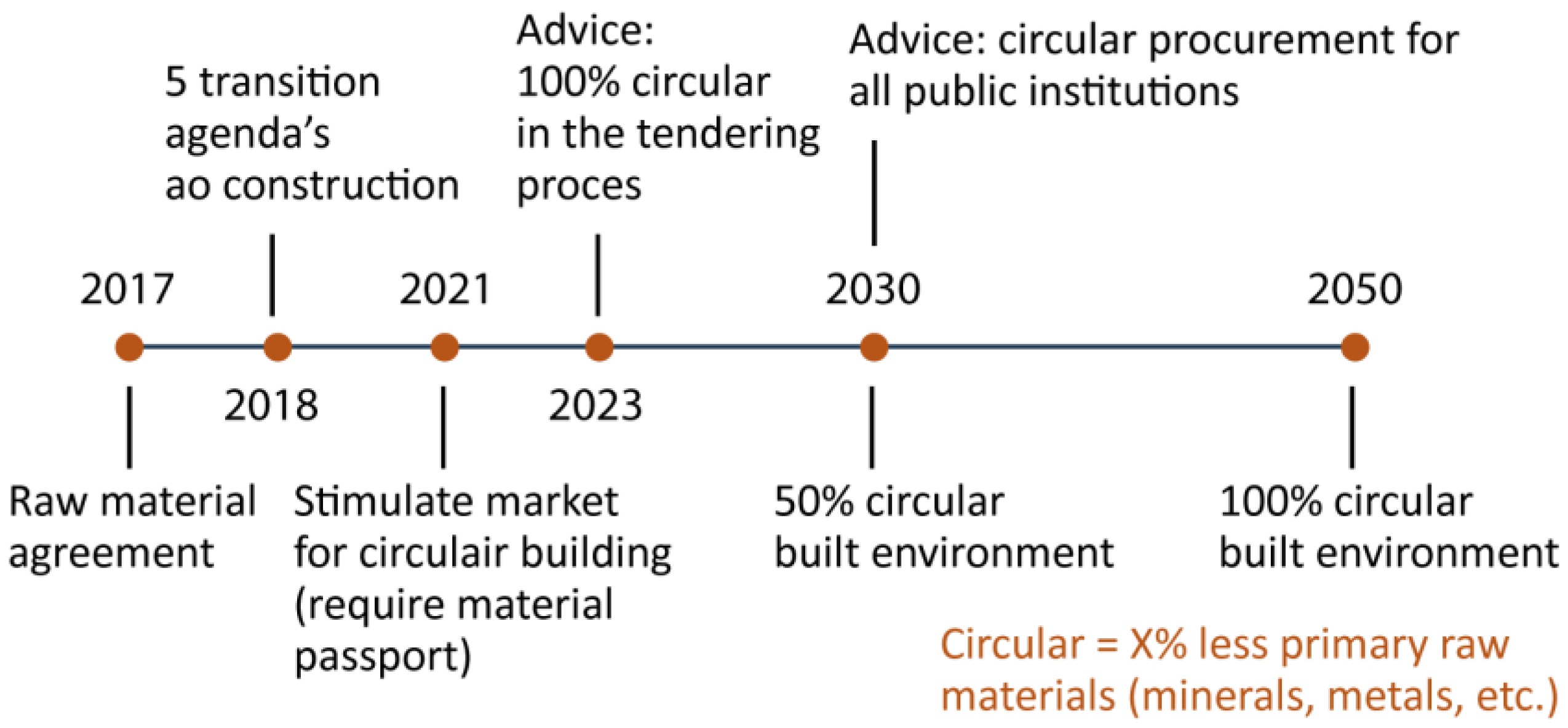
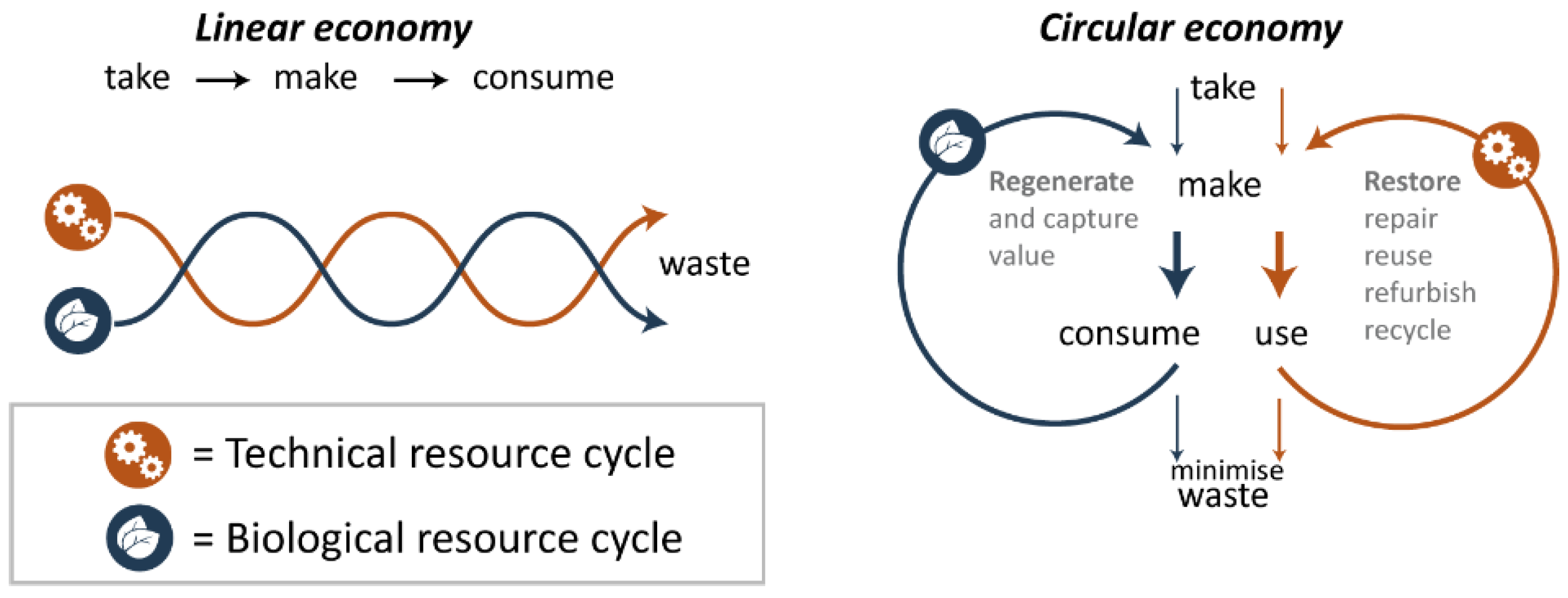
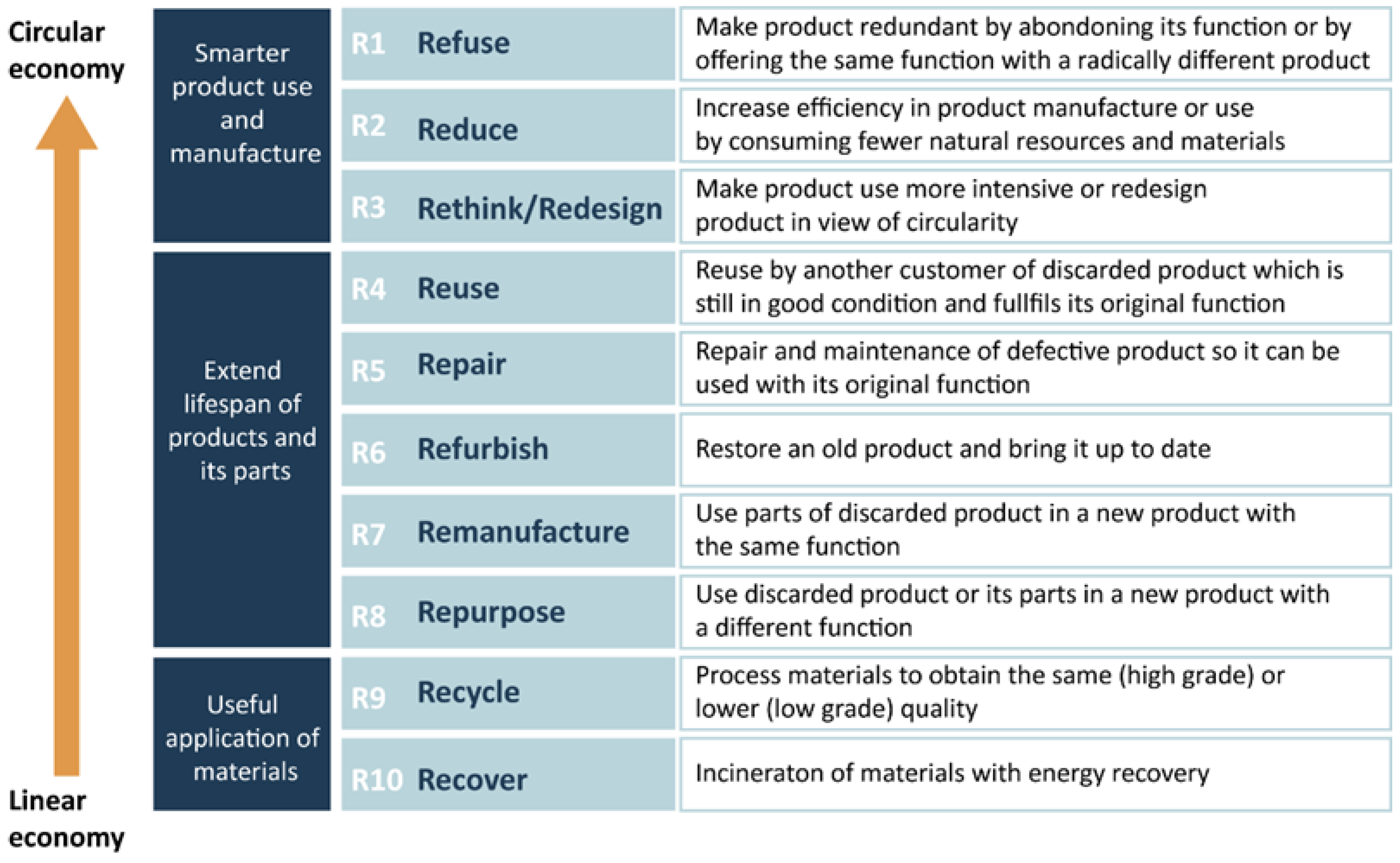
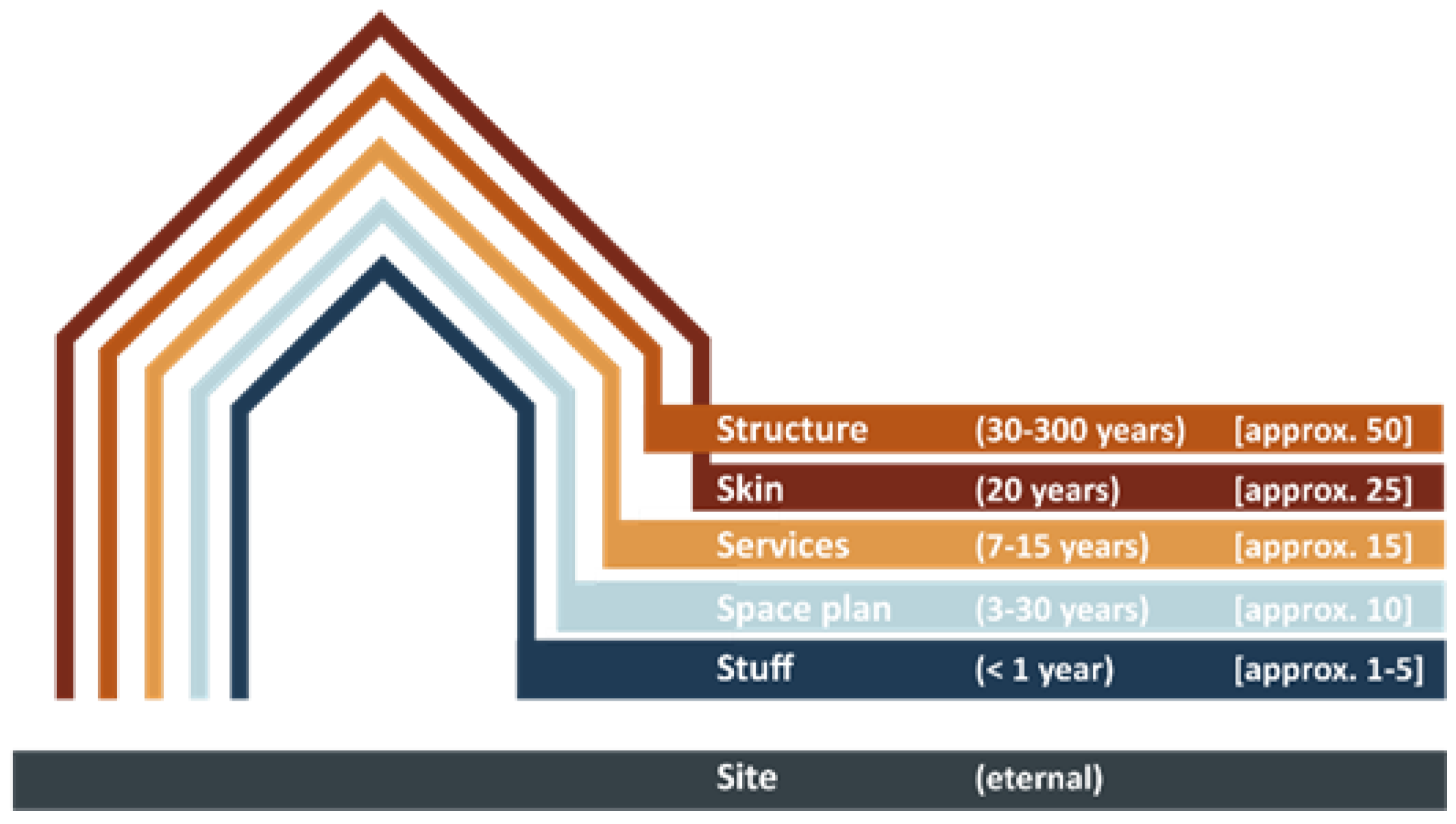


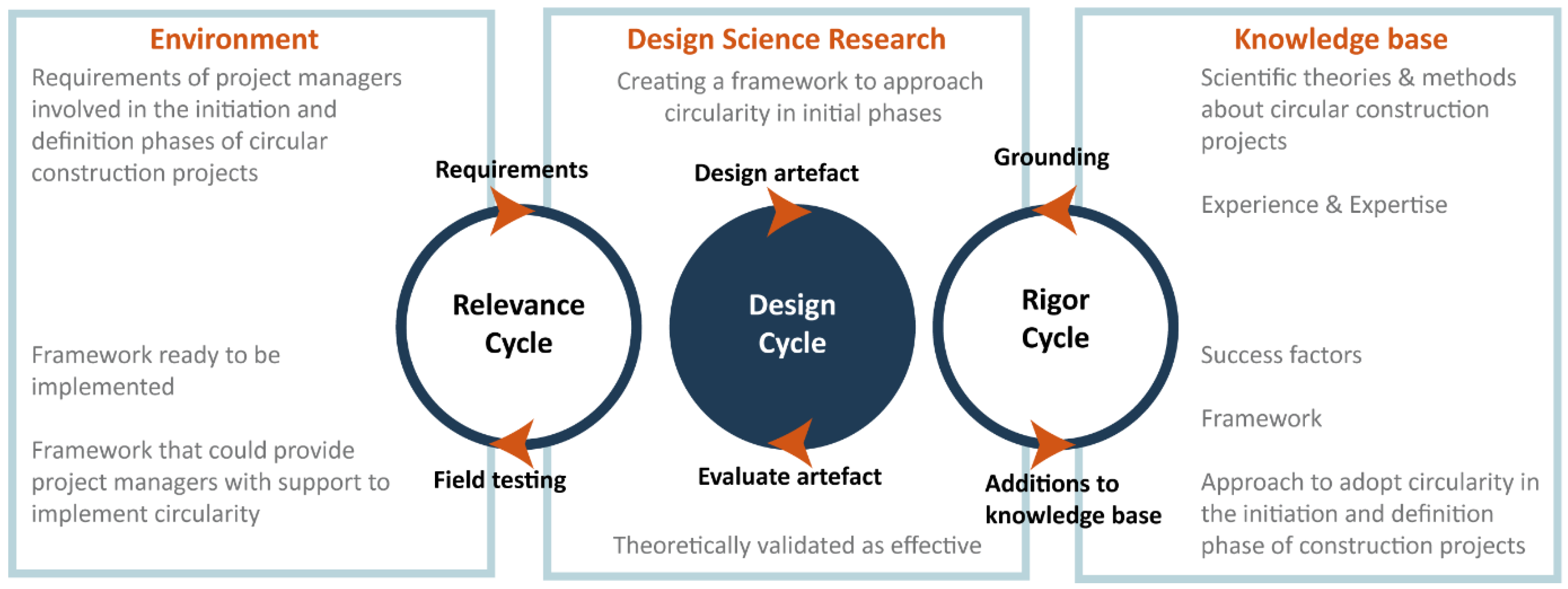
| Code of Project | Type of Project | Current Phase |
|---|---|---|
| Project A | Traditional project | Realisation phase |
| Project B | Traditional project | Realisation phase |
| Project C | (Semi-)Circular project | Realisation phase |
| Project D | (Semi-)Circular project | Realisation phase |
| Project E | (Semi-)Circular project | Completed |
| Project F | (Semi-)Circular project | Design phase |
| Description Questionnaire | Very Unsuccessful | Unsuccessful | Neutral | Successful | Very Successful |
|---|---|---|---|---|---|
| Value questionnaire | 1 | 2 | 3 | 4 | 5 |
| Fuzzy numbers (aij, bij, cij) | (0, 0, 0.25) | (0, 0.25, 0.5) | (0.25, 0.5, 0.75) | (0.5, 0.75, 1.0) | (0.75, 1, 1) |
| Scenario 1 | Scenario 2 | Scenario 3 | Scenario 4 | |||||||
|---|---|---|---|---|---|---|---|---|---|---|
| Group | 1 | 2 | 3 | 1 | 2 | 3 | 1 | 2 | 3 | All |
| Power | 2 | 1 | 3 | 1 | 2 | 3 | 1 | 3 | 2 | 1 |
| Interest | 3 | 1 | 2 | 2 | 3 | 1 | 2 | 1 | 3 | 1 |
| Importance value | 6 | 1 | 6 | 2 | 6 | 3 | 2 | 3 | 6 | 1 |
| Weight | 0.46 | 0.08 | 0.46 | 0.18 | 0.55 | 0.27 | 0.18 | 0.27 | 0.55 | 0.33 |
| Explanation of the scenario | Group 1 and group 3 can col-lectively make the best estimate of what the most successful factors are. The scenario is determined by giving group 1 and 3 the same weight. | It was assumed that group 2 with the project managers would know best which success factors could be applied since all factors that have to be validated were already identified as success factors. Furthermore, group 3 also has more power since it also includes project managers. | It is assumed that group 3 should have the most influence because they can make both considerations and have already performed circular projects in the role of project manager. | It is based on equality between the different groups. It should be noted that this scenario is different compared to the all-respondent values since the numbers of respondents differ per group. | ||||||
Publisher’s Note: MDPI stays neutral with regard to jurisdictional claims in published maps and institutional affiliations. |
© 2022 by the authors. Licensee MDPI, Basel, Switzerland. This article is an open access article distributed under the terms and conditions of the Creative Commons Attribution (CC BY) license (https://creativecommons.org/licenses/by/4.0/).
Share and Cite
Többen, J.; Opdenakker, R. Developing a Framework to Integrate Circularity into Construction Projects. Sustainability 2022, 14, 5136. https://doi.org/10.3390/su14095136
Többen J, Opdenakker R. Developing a Framework to Integrate Circularity into Construction Projects. Sustainability. 2022; 14(9):5136. https://doi.org/10.3390/su14095136
Chicago/Turabian StyleTöbben, Jeanine, and Raymond Opdenakker. 2022. "Developing a Framework to Integrate Circularity into Construction Projects" Sustainability 14, no. 9: 5136. https://doi.org/10.3390/su14095136
APA StyleTöbben, J., & Opdenakker, R. (2022). Developing a Framework to Integrate Circularity into Construction Projects. Sustainability, 14(9), 5136. https://doi.org/10.3390/su14095136






